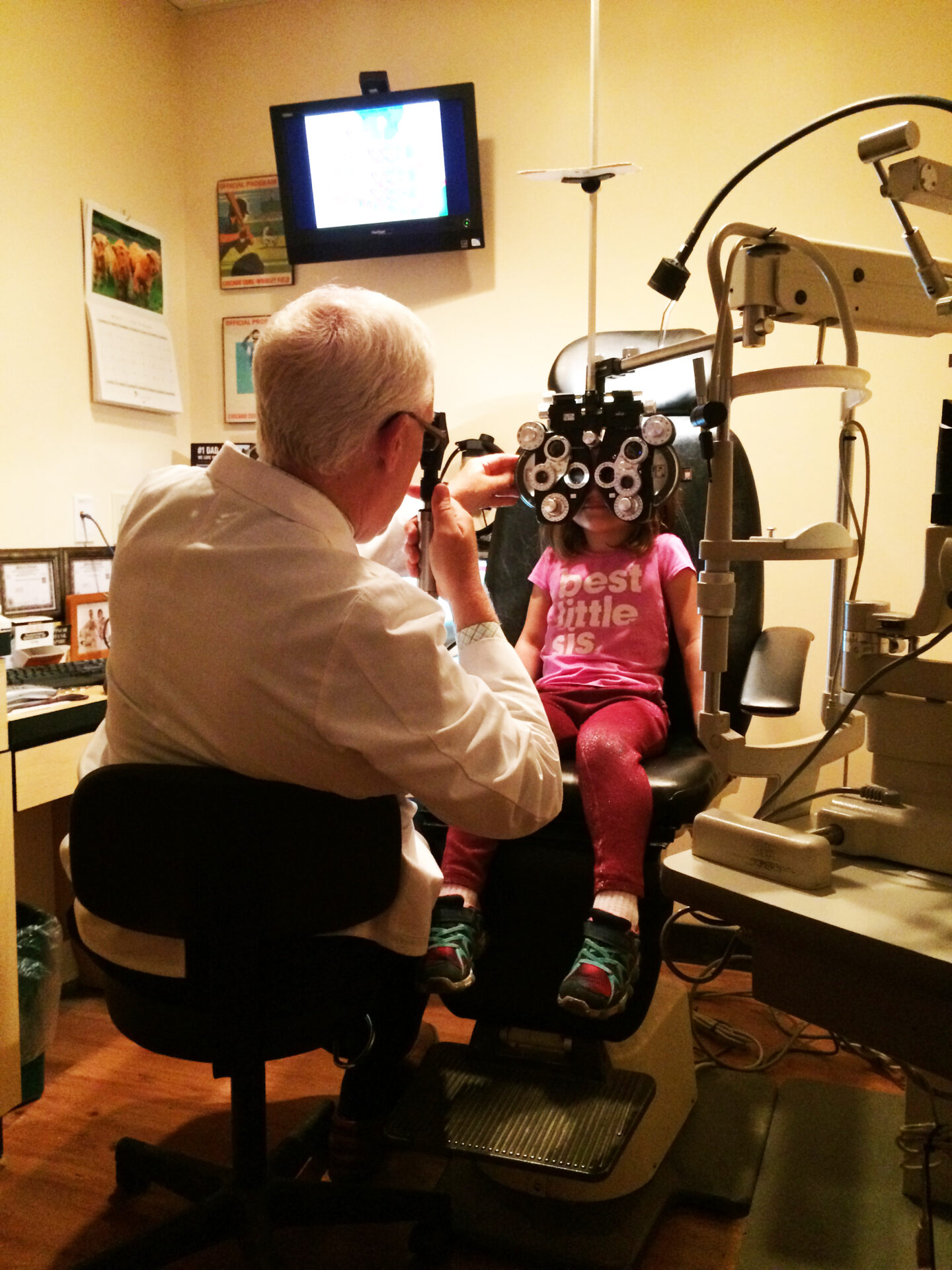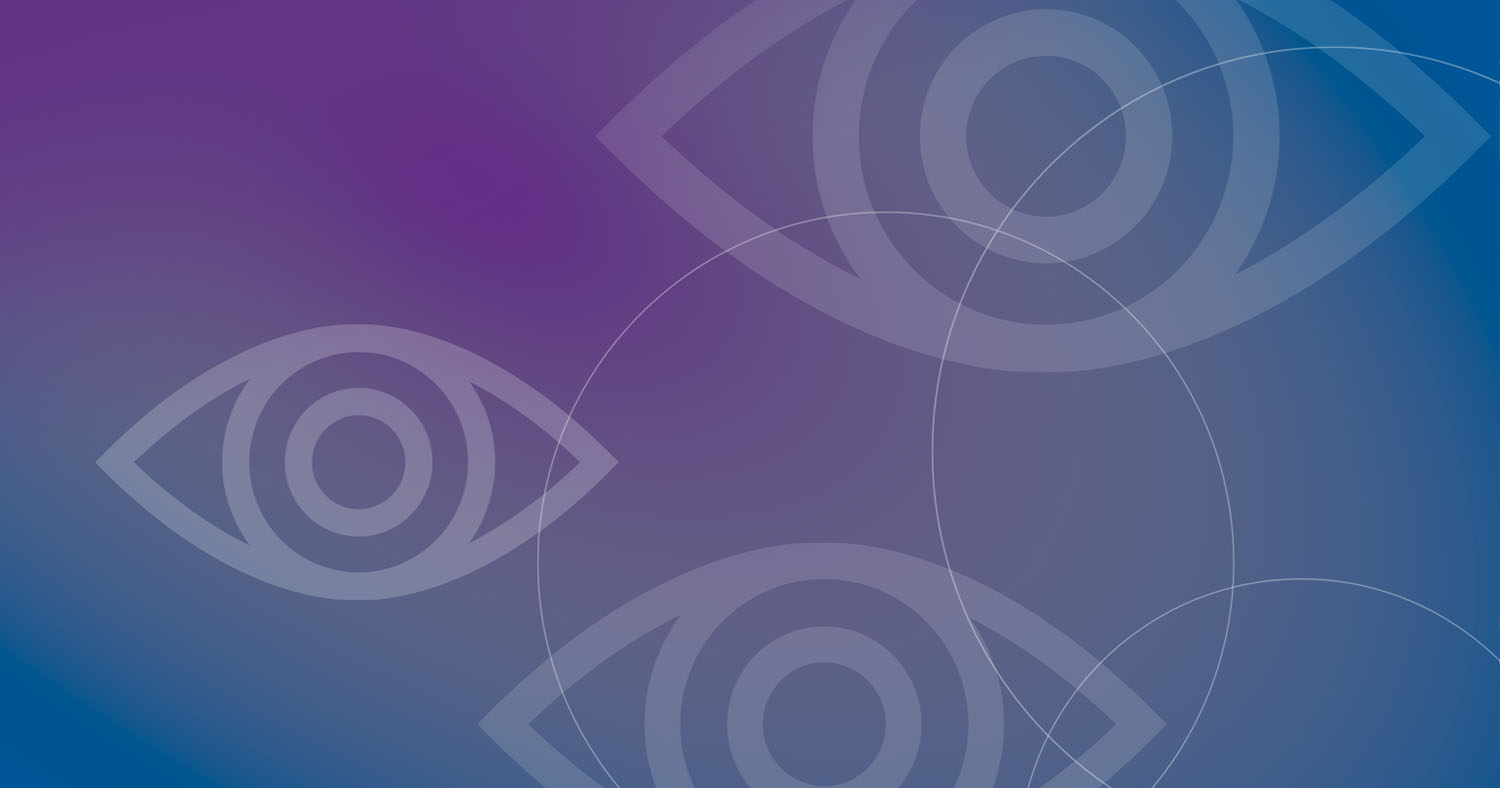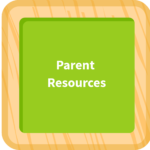Difference Between Vision Screening and Eye Exam (pdf)
If I hadn’t brought my son, I don’t know how long we would have gone . . . he wasn’t aware . . . the teacher wasn’t aware, and I know when he got his glasses he was like, “Wow”. . . . And he kept saying to his sister, “You can just see like this without them?” He was just in amazement. *
What You Need to Know:
We can’t see that kids can’t see. Kids rarely know they can’t see. Vision screening helps find children who need to see an eye doctor for an eye examination to find out if children have vision disorders or eye health problems.
Why Should Your Child Have a Vision Screening?
Vision screening is done to find children who may have or be at risk of having a vision disorder or eye health problem that could affect their learning, social and emotional development, ability to play sports, and even future job opportunities.
What is a Vision Screening?
Trained vision screeners look at your child’s eyes for signs and symptoms of vision problems. They also use eye charts or digital instruments to check your child’s vision and eyes. Vision screeners cannot tell you if your child has a vision disorder. They will tell you if your child appears to see okay or they will refer your child for an eye examination by an eye doctor.
Where is Vision Screening Done?
Vision screening is done in the community where you live. Vision screening happens at your Head Start program, preschool, school, public health department, and in your child’s health care provider’s office during a well-child visit.
What Do You Do if Your Child is Referred From a Vision Screening for an Eye Examination by an Eye Doctor?
You call an eye doctor and make an appointment for your child to have an eye examination. You may need to make an appointment with your child’s primary health care provider to receive a referral for an eye examination. Either way, tell your child’s primary health care provider or eye doctor that your child received a referral from a vision screening.
The eye doctor might be an ophthalmologist, an optometrist, a pediatric ophthalmologist, or a pediatric optometrist. The eye doctor doing your child’s eye examination should be trained and experienced in working with young children.
Passing a vision screening does not mean there is no chance of your child having a vision disorder or eye health problem. Vision changes every year. If your child passes a vision screening and you still have a concern about how well your child can see, take your child to an eye doctor for an eye examination.
For more information:
- Signs of Vision Problems in Children
- Vision Screening Table of Evidence-Based Tools
- Vision Screenings and Eye Exams
Taking a Deeper Dive . . .
How Common are Vision Disorders?
Up to 1 in 17 young children, 1 in 5 Head Start children, and an estimated 1 in 4 or 5 school-aged children have undiagnosed vision disorders.
What Happens During a Vision Screening?
Birth to the 1st Birthday:
Some programs, such as Early Head Start, may use a checklist to discuss 18 vision development milestones with you. This is a link to that checklist in English or Spanish:
-
- English: https://nationalcenter.preventblindness.org/wp-content/uploads/sites/22/2020/05/18-Key-vision-questions-to-ask-in-year-1_version-5.27.2020.pdf
- Spanish: https://nationalcenter.preventblindness.org/wp-content/uploads/sites/22/2020/06/Spanish_18-Key-vision-questions-to-ask-in-year-1_version-5.27.2020-1.pdf
This is a link to a document you can use at home to check milestones during your infant’s first year of life.
Ages 1 and 2 Years:
Community vision screeners and medical assistants or nurses in a doctor’s office might use “instruments” to give them information about your child’s eyes.
Using an instrument is similar to taking a picture of your child’s eyes. Your child looks at the instrument and does not need to talk. The instrument provides information about your child’s eyes on a screen after your child looks at the instrument for a few seconds. The information tells the screener if your child passed the screening or if an eye examination is recommended.
The information about the shape of your child’s eyes may suggest your child has hyperopia (farsightedness), myopia (nearsightedness), anisometropia (one eye is more nearsighted or farsighted than the other eye or one eye may be nearsighted and one eye may be farsighted), or astigmatism (blurred vision at all distances). The information may also suggest your child has eye misalignment, meaning both eyes may not look at an object, such as a toy, at the same time.
Your child will probably not be rescreened if they do not pass screening with an instrument. Instead, the information on the instrument screen will suggest a referral for an eye examination by an eye doctor.
Ages 3, 4, and 5 Years:
Head Start and school nurse vision screeners will begin a vision screening by looking at your child’s eyes to check Appearance, Behaviors, and Complaints. Your child will receive a referral for an eye examination from an eye doctor if the vision screener has a concern about your child’s eyes, even if your child passes vision screening.
Eye Charts:
Community vision screeners, including medical assistants or nurses in your child’s health care provider’s office, may use eye charts with pictures or letters to screen vision. Vision screeners may use digital instruments instead of eye charts.
Vision screeners use eye charts to check your child’s visual acuity, or how clear your child’s vision is when looking at the eye chart.
Your child will be asked to name the pictures or letters (called optotypes) on the eye chart, first with one eye covered and then with the other eye covered. Your child can either name the optotypes or point to optotypes on a card to play a matching game.
Special glasses that cover one eye and leave the other eye uncovered might be used. The vision screener should never ask your child to cover an eye with his or her hand. Your child can peek around a hand or through fingers, which can lead to vision screening results that are not true.
Your child must correctly name the majority of optotypes on specific lines to pass vision screening. The specific line on the chart depends on your child’s age. For example, a 3-year-old child must be able to correctly name the majority of optotypes on the 20/50 line with each eye separately to pass. Children ages 6 years and older, and adults, must correctly name the majority of optotypes on the 20/32 line with each eye separately to pass.
If your child does not correctly name or point to the majority of optotypes on the eye chart line they should pass, your child does not pass vision screening. Your child might be screened again in 2 weeks to 6 months. This is called rescreening. Or your child might be referred to an eye doctor for an eye examination to determine if the child truly has a vision disorder.
Some vision screeners will go below the line your child should pass to see if your child has what is called a “2-line difference” between the lines. For example, if your child could pass the majority of optotypes on the 20/20 line with one eye, but only the 20/32 line with the other eye, your child will receive a referral for an eye examination because of the difference between the two eyes.
You will probably receive a paper from a community vision screener after the vision screening that will tell you if your child passed or if you should make an appointment with an eye doctor for an eye examination. You should take this paper with you to the eye doctor’s visit.
You might also receive a phone call from the vision screener to tell you the results of your child’s vision screening.
If the screening occurs in your child’s health care provider’s office, the health care provider will tell you if your child passed the vision screening of if you should take your child to an eye doctor for an eye examination.
Digital Instruments:
Your Head Start vision screener, a school nurse, a medical assistant or nurse in your child’s health care provider office, or other community screener might use an “instrument” to give information about the shape of your child’s eyes.
Using an instrument is similar to taking a picture of your child’s eyes. Your child looks at the instrument and does not need to talk. The instrument provides information about your child’s eyes on a screen after your child looks at the instrument for a few seconds. The information tells the screener if your child passed the screening or if an eye examination is recommended.
The information about the shape of your child’s eyes may suggest your child has hyperopia (farsightedness), myopia (nearsightedness), anisometropia (one eye is more nearsighted or farsighted than the other eye or one eye may be nearsighted and one eye may be farsighted), or astigmatism (blurred vision at all distances). The information may also suggest your child has eye misalignment, meaning both eyes may not look at an object, such as a toy, at the same time.
Your child will probably not be rescreened if they do not pass screening with an instrument. Instead, the information on the instrument screen will suggest a referral for an eye examination by an eye doctor.
Ages 6 Years and Older:
Screeners can do instrument screening only when your child is 1, 2, 3, 4, and 5 years old. Eye chart screening is used when your child is aged 6 years and older, unless your child cannot do eye chart screening.
When your child can name letters, your child will be screened with a chart with Sloan Letters and may look like this chart.
Vision screeners use eye charts to check your child’s visual acuity, or how clear your child’s vision is when looking at the eye chart.
Your child will be asked to name the letters (called optotypes) on the eye chart, first with one eye covered and then with the other eye covered.
Special glasses that cover one eye and leave the other eye uncovered might be used until your child is age 10 years. The vision screener should never ask your child to cover an eye with his or her hand. Your child can peek around a hand or through fingers, which can lead to vision screening results that are not true.
Your child should be asked to cover one eye at a time beginning at age 10 years with one of these covers (called occluders).
Your child must correctly name the majority of optotypes on the 20/32 line with each eye separately to pass. (This is the same line you should also pass.)
If your child does not correctly name the majority of optotypes on the 20/32 line, your child might be screened again in 2 weeks to 6 months. This is called rescreening. Or your child might be referred to an eye doctor for an eye examination to determine if the child truly has a vision disorder.
Some vision screeners will go below the line your child should pass to see if your child has what is called a “2-line difference” between the lines. For example, if your child could pass the majority of optotypes on the 20/20 line with one eye, but only the 20/32 line with the other eye, your child will receive a referral for an eye examination because of the difference between the two eyes.
You will probably receive a paper from a community vision screener after the vision screening that will tell you if your child passed or if you should make an appointment with an eye doctor for an eye examination. You should take this paper with you to the eye doctor’s visit.
You might also receive a phone call from the vision screener to tell you the results of your child’s vision screening.
If the screening occurs in your child’s health care provider’s office, the health care provider will tell you if your child passed the vision screening of if you should take your child to an eye doctor for an eye examination.
More Important Information:
Vision screening determines if your child should see an eye doctor for an eye examination. The eye doctor might be an ophthalmologist, an optometrist, a pediatric ophthalmologist, or a pediatric optometrist. The eye doctor doing your child’s eye examination should be trained and experienced in working with young children.
Only the eye doctor can tell you if your child has a vision or eye health problem and whether any treatment is required. The eye doctor will recommend specific treatment if your child has a vision or eye health problem.
The eye doctor might prescribe eyeglasses or tell you everything looks okay now, but you should make another appointment in 6 months or 1 year.
If your child’s eye doctor tells you that your child’s vision and eye health is okay, but recommends you return for a follow-up visit, please know this was not a “bad” referral or your vision screeners were incorrect. Your child is in the eye care system, and the eye doctor will check your child’s vision again the next visit to decide if your child needs glasses at that time.
Passing a vision screening does not mean there is no chance of your child having a vision problem. Vision changes every year. If your child passes a vision screening and you still have a concern about how well your child can see, take your child to an eye doctor for an eye examination.
For more information on vision screening guidelines for children of all ages, visit Vision Screening Guidelines by Age at https://nationalcenter.preventblindness.org/vision-screening-guidelines-by-age/
References
*Irving, E. L., Sivak, A. M., & Spafford, M. M. (2018). “I can see fine”: Patient knowledge of eye care. Ophthalmic & Physiological Optics, 38(4), 422–431. https://doi.org/10.1111/opo.12566
U.S. Preventive Services Task Force. (2017). Vision screening in children ages 6 months to 5 years (Evidence Synthesis No. 153). Rockville, MD: Agency for Healthcare Research and Quality, U.S. Department of Health and Human Services. Retrieved from https://www.ncbi.nlm.nih.gov/pubmedhealth/PMH0098873/
Varma, R., Tarczy-Hornoch, K., & Jiang, X. (2017). Visual impairment in preschool children in the United States: Demographic and geographic variations from 2015 to 2060. JAMA Ophthalmology, 135(6), 610-616.
Ying, G. S., Maguire, M. G., Cyert, L. A., Ciner, E., Quinn, G. E., Kulp, M. T., Orel-Bixler, D., Moore, B., & Vision In Preschoolers (VIP) Study Group (2014). Prevalence of vision disorders by racial and ethnic group among children participating in head start. Ophthalmology, 121(3), 630–636. Retrieved from https://www.ncbi.nlm.nih.gov/pmc/articles/PMC4128179/pdf/nihms603561.pdf





